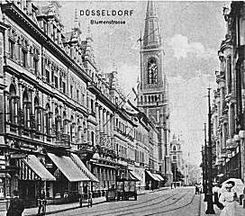Blumenstrasse (Düsseldorf)
| Flower Street | |
|---|---|
| Street in Düsseldorf | |
| Düsseldorf, Blumenstrasse around 1909, postcard. | |
| Basic data | |
| place | Dusseldorf |
| District | City center |
| Connecting roads | Königsallee and (formerly Bismarckstraße) today Berliner Allee |
| Cross streets | Schadowstrasse, Königsstrasse, Josephinenstrasse and Martin-Luther-Platz |
| Buildings | Hotel Heck, Wehling'sche commercial buildings, Cornelius House, Johanneskirche on Martin-Luther-Platz |
| use | |
| User groups | Pedestrian traffic , bicycle traffic , car traffic , public transport |
| Road design | tram |
The Flower Street is a street in the Düsseldorf district of the city center .
location

Blumenstrasse joins Königsallee , Düsseldorf's luxury shopping street, and in the pre-war period led to Bismarckstrasse, but today it joins Berliner Allee . It crosses Schadowstraße , the most important shopping street in Düsseldorf, then Königsstraße, Josephinenstraße and Martin-Luther-Platz with the Johanneskirche .
According to Hugo Weidenhaupt, it stood out in the register and chronological table of the complete works. Düsseldorf and, according to Peter Hüttenberger, in Die Industrie- und Verwaltungsstadt (20th Century) , primarily through its commercial buildings such as the Wehling's commercial buildings and the Cornelius House.
Development
- The Hotel Heck, which was destroyed in the Second World War, was honored by the Düsseldorf Architects and Engineers Association in Düsseldorf and its buildings (1904). The secular building with generous interior fittings was built in 1889 by the architects Bernhard Tüshaus and Leo von Abbema :
“The 'Hotel Heck' on Blumenstrasse, built in 1889 by the architects Tüshaus & von Abbema, contains 30 rooms with 36 beds (Fig. 369). The large dining rooms and halls as well as the good kitchen facilities allow larger festivities to be held (Figs. 370 and 371). "
- The Cornelius house was located at Königsallee 9/10 (today's house number 18), at the corner of Schadowstrasse and Blumenstrasse. The representative secular building was built from 1896 to 1897 by the Düsseldorf architectural office Klein & Dörschel , survived the air raids on Düsseldorf except for minor damage and was rebuilt. The old building was later demolished in favor of a new one.
- Alois Ludwig decorated the facades of Wehling 's commercial buildings at Blumenstrasse 7 and 9 . He was a representative of the Viennese Art Nouveau and works with colored glazed ceramics . In addition to the house at Schadowstrasse 23 with “figuratively glazed faience panel cladding with figurative representations”, he worked on buildings at Blumenstrasse 7 and 9 with “graceful glass inlays”. Gottfried Wehling , who designed the houses, lived at Blumenstrasse 9 from December 21, 1907 until his death.
“The Wehling business groups Königsallee No. 9 and 11, as well as Blumenstrasse No. 7 and 9, built in the years 1901–1902 by the architects Wehling & Ludwig, show street front designs in a modern design language. [...] The facades on Blumenstrasse show, above the wooden shop window systems, ashlar structures between plastered surfaces with graceful glass inlays (Fig. 430, 431 and 432). "
- The Johanneskirche
Web links
Individual evidence
- ^ Hugo Weidenhaupt: Register and time table for the complete works. In: Düsseldorf. History from the origins to the 20th century. Volume 4. Schwann, Düsseldorf 1990, ISBN 3-491-34224-4 , p. 33 (Blumenstrasse around 1900 III / 201 fig., 203 fig.)
- ^ Peter Hüttenberger: The industrial and administrative city (20th century). In: Düsseldorf. History from the origins to the 20th century. Volume 3. Schwann, Düsseldorf 1990, ISBN 3-491-34223-6 , p. 203 Fig. 43 Königsallee office building, corner of Schadowstrasse and Blumenstrasse, built in 1896/97.
- ^ Peter Hüttenberger: The industrial and administrative city (20th century). In: Düsseldorf. History from the origins to the 20th century. Volume 3. Schwann, Düsseldorf 1990, ISBN 3-491-34223-6 , p. 201 Fig. 42. Commercial buildings at Blumenstrasse 7–9, around 1900.
- ^ Architects and Engineers Association in Düsseldorf (ed.): Düsseldorf and its buildings. L. Schwann, Düsseldorf 1904, p. 307, fig. 369 exterior view; Fig. 371 Ground floor plan
- ^ A b Architects and Engineers Association in Düsseldorf (ed.): Düsseldorf and its buildings. L. Schwann, Düsseldorf 1904, pp. 333–334 (Fig. 430 Group Blumenstrasse 7 and 9)
Coordinates: 51 ° 13 ′ 28.2 " N , 6 ° 46 ′ 53.8" E





